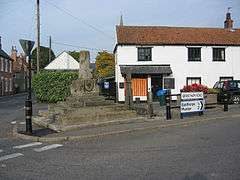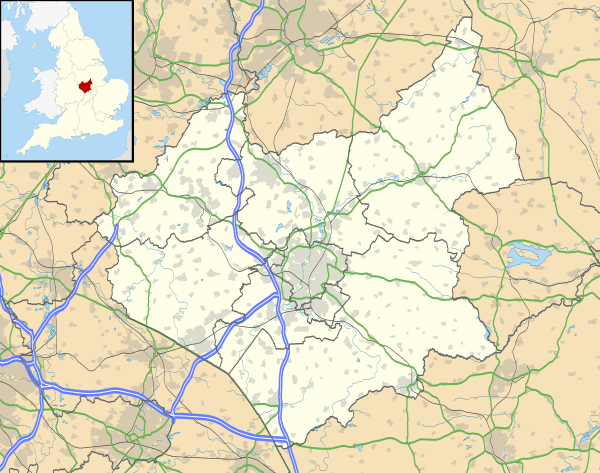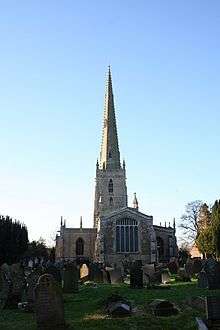Bottesford, Leicestershire
Bottesford is an English village and civil parish. It lies in the Vale of Belvoir and forms part of the Borough of Melton in Leicestershire.
| Bottesford | |
|---|---|
 Bottesford Market Cross | |
 Bottesford Location within Leicestershire | |
| Population | 3,587 (2011) |
| OS grid reference | SK8038 |
| District |
|
| Shire county | |
| Region | |
| Country | England |
| Sovereign state | United Kingdom |
| Post town | NOTTINGHAM |
| Postcode district | NG13 |
| Dialling code | 01949 |
| Police | Leicestershire |
| Fire | Leicestershire |
| Ambulance | East Midlands |
| UK Parliament | |
Location
Bottesford is about 20 miles (32 km) east of Nottingham and 16 miles (26 km) north of Melton Mowbray. The village is the largest in the Vale of Belvoir and is near to Belvoir Castle, home to the Duke and Duchess of Rutland. It had a population of 3,587 at the time of the 2011 census.[1] It borders parishes in Leicestershire, Lincolnshire and Nottinghamshire, such as Redmile, Sedgebrook and Elton respectively.
The local amenities include a post office, a railway station, a library, a church, a convenience store, three restaurants and three pubs.
Name
Bottesford derives its name from the Anglo-Saxon "Ford belonging to the botl" (house). The ford was over the River Devon. Bottesford is listed in the 1086 Domesday Book as "Botesford", in the hundred of Framland.[2][3] Historically, Bottesford was closely associated with the Earls and Dukes of Rutland.
History

The village was built around the River Devon (pronounced Dee-von) and was named because of the ford at the centre of the village. St Mary the Virgin's Church, sometimes known as the "Lady of the Vale", is a large medieval church at the centre of the village. Like many churches, this was built over the centuries in a mixture of architectural styles. The lower part of the chancel dates from the 12th century with the remainder added during the next 300 years. The nave roof was finally completed in 1740. The octagonal crocketed spire is thought to be the tallest in the county at 210 feet (64 metres). There are two gargoyles on the south transept. A headstone to Thomas Parker and a table tomb in the churchyard are both Grade II listed, as are the gate piers and gates to the churchyard to the north. The church is also the burial place of several earls of Rutland. One of the Rutland tombs is famous for its inscription, which attributes a death to witchcraft by the Witches of Belvoir. Most of the church dates from the 15th century, but the chancel was rebuilt in the 17th century to accommodate the Rutland monuments. These fill the chancel and give a view of changing aristocratic taste in the 16th and 17th centuries.[4] After the Manners family were elevated to the dukedom of Rutland in 1703, they built a mausoleum in the grounds of Belvoir Castle, the family home.[5] All the dukes have been buried there.[6]
There is a local website covering many sides of Bottesford's local history,[7] including mounting evidence of occupation in Roman times and earlier.[8] Bottesford was the venue of one of the country's early friendly societies, thought to have been founded in the 1750s. It provided members with sickness and funeral benefits for over 200 years.[9] Eleven contributors from the history group produced in 2009 a book on the local history since 1850.[10]
From December 1941, there was a Second World War RAF Bomber Command airfield located to the north near Long Bennington, called RAF Bottesford. Initially it hosted No. 3 Group RAF, then after serving USAAF's IX Troop Carrier Command for D-Day, was used by No. 5 Group from late 1944. It is no longer used as an airfield, but the runways can still be seen.
Entertainers Laurel and Hardy stayed for Christmas 1952 at the Bull Inn, where the landlady was Stan Laurel's sister Olga. They were appearing at the Empire Theatre in Nottingham at the time. There is a plaque recording this on the building.[11]
There were two brickyards at Beckinthorpe in the 19th century, one also producing the unique Bottesford Blue pantiles to be seen on some local buildings.[12] Local employment declined in the 20th century. The four pubs, six restaurants, at least 16 retailers and 20 odd small producers and service providers today are one-person or family concerns. Not so the earlier building firm of William Roberts Ltd. Joseph William Roberts (1898–2010) was born and bred in Sutton-cum-Granby, then schooled in Granby, Nottinghamshire and in Bottesford. He moved to the latter and started his firm in 1937, aged 20. It employed over 500 people at one time and branched out as a funeral undertaker.[13]
Character and appearance
The village is somewhat unusual in Leicestershire. Its buildings reflect the traditions of neighbouring Nottinghamshire and Lincolnshire, as well as local influences, as local materials, initially locally quarried ironstone, but latterly local bricks and distinctive roofing tiles.
There are several open areas within the village, notably an area to the north-east of the churchyard, the churchyard itself, and an area of trees to the south of Devon Lane. Trees play a significant part in the street scene in most of Bottesford.
The River Devon flows through the village, almost circling the church. Along its banks in the centre of the village, the soil is a pebbly sand known locally as running sand. Views within the village tend to be intimate and enclosed, though the wider Grantham Road provides a slightly extended view out of the village towards Grantham.
Bottesford has many listed buildings including the grade I listed 13th-century Church of St Mary the Virgin. There are two scheduled monuments within the village – Fleming's Bridge and the stone cross in the Market Place. The stocks and whipping post are Grade II listed. One of the Grade II listed buildings, Providence Cottage in Rectory Lane, is dated 1723 in burnt bricks on the eastern elevation and has the initials REH set into the elevation. The roof is now pantiled, but the slope suggests that it was thatched in times gone by. The Duke of Rutland's Almshouse, also Grade II listed, was begun in 1590 and was a home for elderly local men called bedesmen (i. e. almoners), having once been a hospital. The building has two M-shaped roofs of differing pitches, both with concrete tiles dating from 1985. The Rectory, Grade II listed, is an ironstone and brick building dated 1708, enlarged in the 19th century and altered in 1988. It stands in Rectory Lane behind wrought iron gates, amid large, landscaped gardens, and has a slate roof. The police station, in Queen Street, is likewise Grade II listed and dates from 1846. It is in red brick with a slate roof and three bays. The central bay projects under a pediment and the building is an early example of a purpose-built police station. Market Street is the location of the Grade II listed Dr Fleming's House, which was once a terrace of women's almshouses built in ironstone and mainly rebuilt in brick in the late 18th century. A stone plaque over a door reads "Dr. Fleming's Hospital 1620". There are several Grade II listed properties in High Street, including the Thatched Restaurant, set back from the road in spacious grounds and the only remaining thatched building in the village.
There are many other listed buildings within the conservation area.
Governance
Bottesford is in the Melton borough of Leicestershire and in the Rutland and Melton constituency. The current Member of Parliament is the Conservative Alicia Kearns.
The civil parish includes the villages of Bottesford, Easthorpe (now effectively a suburb of Bottesford), Muston and Normanton. The parish council has nine members.
Transport
The village is served by Bottesford railway station on the Nottingham, Grantham and Skegness line. There are also No. 24 and 26 buses, which run to Melton Mowbray at least every two hours, and other services to Grantham and Bingham.
The town was bypassed by the A52 road in February 1989 at a then cost of £3 million.[14]
Landmarks
.jpg)
The Victory Commemoration (or VC) Hall is the local name for Bottesford Old Village Hall.[15] The name came about because some of the funds used to purchase the original hall came from leftover money raised by the village during the Second World War to send parcels to those serving in the armed forces.
A new village hall was built in 2003, mainly funded by a grant from Awards for All (Lottery) and contributions from the local people.[16] To mark the celebration of the Golden Jubilee of Elizabeth II in 2002, several large developments occurred in Bottesford, including the creation of a memorial green.
One of the 2010 Low Carbon Awards given by the Royal Institute of British Architects went to a house in Bottesford designed by architects Allan Mulcahy.[17]
Clubs and groups
The village has several clubs, including two badminton clubs, a bowling club, a cricket and social club, four football clubs, several sections of the Scout and Guides movement as well as many other clubs and events such as a youth club catering for 11 to 19-year-olds and a skate park. The village has several charity groups primarily raising funds to provide for new facilities locally. One group raising funds in Bottesford in particular is the Vale of Belvoir Lions.
Local community information has appeared since 2002 in the Village Voice newsletter, which is delivered free to every house in the parish.[18]
Education
Bottesford has a playgroup and a primary school – Bottesford Primary School – and a high school – The Priory Belvoir Academy. The latter had its first group of year 10s in 2008, having expanded from being a middle school that year. This initially controversial change was hailed as a success after the schools inspectorate Ofsted rated Belvoir as Outstanding in its 2010 inspection report.[19] It was rated Good in leadership, behaviour, teaching and achievement, and Outstanding in sixth-form provision in its most recent Ofsted report.[20]
There is a public library in the Old School, Grantham Road.[21]
Places of worship
There are Church of England churches in Bottesford: (St Mary's) and Muston (St John the Baptist). The poet George Crabbe (1754–1832) moved to Muston Rectory from Stathern in 1789, remaining as incumbent of Muston and of West Allington, Lincolnshire, until 1792. His Natural History of the Vale of Belvoir was a pioneering study of the district.[22]
Bottesford Methodist Church is in Devon Lane. The Baptist Church is in Queen Street.
Notable people
In birth order
- Thomas Manners, 1st Earl of Rutland (died 1543), courtier and soldier, was buried in Bottesford.
- Abraham Fleming (died 1607), cleric, writer and translator, died in Bottesford. His brother Samuel was Rector here in 1581–1620.
- Edward Manners, 3rd Earl of Rutland (died 1587), public official, was buried in Bottesford, as were the other earls of Rutland up to John Manners, 8th Earl of Rutland (died 1679), politician.
- Joan Flower (died 1619) of Bottesford and her daughters Margaret and Philippa (executed 1619) were among the ostensible Witches of Belvoir and tried as such.
- Henry Beresford Garrett (baptised Henry Rouse in Bottesford in 1818), committed several violent crimes in New Zealand and Australia.[23]
- William Antliff (born 1848), a Derbyshire county cricket player, was born in Bottesford.
- John Parnham (born 1856), a professional cricketer active in the 1880s, was born in Bottesford.
- Willie Young (born 1951), a Scottish footballer who appeared 237 times for Arsenal F.C., now owns a dog kennels in Bottesford.
- Robert Harris (born 1957), novelist and broadcaster, attended Belvoir High School.
- Luke Wright (born 1985), an England all-round cricketer, was born in Bottesford.
Crime
Ten-year-old Rosie May Storrie of Bottesford was murdered during a house party in Normanton on 30 December 2003, two days after she had made her first stage appearance as a dancer in a pantomime. She was found by other guests smothered and partly stripped, and died in hospital 36 hours later. Paul Smith of Sedgebrook, aged 18, was convicted of the murder.[24]
The Rosie May Storrie Memorial Fund established by her parents has raised over £270,000 towards charity work with children, notably a Rosie May Children's Home at Boossa, Galle, Sri Lanka.[25]
References
- Retrieved 3 February 2013.
- Open Domesday Online: Bottesford, Leicestershire, accessed November 2019.
- Eckwall 1960.
- J. Betjeman, ed., Collins Pocket Guide to English Parish Churches: the North. London: Collins, 1968, p. 166.
- English Heritage listing of the mausoleum as a Grade II historic building: Retrieved 5 February 2013.
- A pictorial description of the chancel with its monuments. Retrieved 5 February 2013.
- Bottesford Living History Retrieved 19 September 2010. Archived 27 June 2011 at the Wayback Machine
- Retrieved 6 October 2010.
- Retrieved 6 October 2010.
- Not Forgetting Aspects of Village Life in Bottesford, Easthorpe, Muston and Normanton (Bottesford, 2009).
- Leicestershire Magazine, 31 July 2010 "Archived copy". Archived from the original on 7 December 2010. Retrieved 6 October 2010.CS1 maint: archived copy as title (link). Retrieved 6 October 2010.
- Retrieved 6 October 2010.
- Grantham Matters, 19 August 2016 Retrieved 6 April 2020.
- History website Retrieved 31 May 2017.
- History website Retrieved 31 May 2017.
- Bottesford VC Hall Archived 26 September 2007 at the Wayback Machine
- This is Leicestershire report: Retrieved 9 October 2010. Archived 6 October 2010 at the Wayback Machine
- Retrieved 10 October 2010. Archived 25 April 2011 at the Wayback Machine
- Leicestershire government site
- Published 8 June 2015 Retrieved 4 July 2017.
- John Marius Wilson: Imperial Gazetteer of England and Wales, 1870-72.
- The Encyclopedia of New Zealand Retrieved 3 January 2015.
- BBC News. Retrieved 9 July 2020.
- Charity website. Retrieved 12 September 2012. Archived 16 May 2011 at the Wayback Machine
External links
| Wikimedia Commons has media related to Bottesford, Leicestershire. |